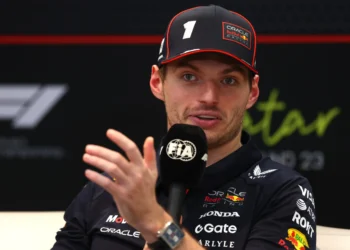The Qatar Grand Prix had everything fans could want: safety cars, fierce battles, and high-stakes drama. But what began as an electrifying race descended into chaos thanks to one glaring failure of race control—over a wing mirror. Yes, a wing mirror.
What should’ve been a straightforward safety intervention turned into a catastrophic blunder that ruined multiple drivers’ races, flipped the Constructors’ Championship upside down, and cast a harsh spotlight on an FIA already under fire for its decision-making.
The Mirror That Broke the Race
The drama began when Alex Albon’s Williams shed its side mirror on the main straight, landing precariously on the overtaking line at the circuit’s fastest section. The FIA acknowledged the hazard—eventually deploying yellow flags, though inconsistently alternating between single and double-waved signals. But they didn’t act decisively to remove the debris. Instead, race control seemingly waited for…what exactly? The mirror to miraculously clear itself?
Predictably, disaster struck. Valtteri Bottas obliterated the mirror at full speed, scattering debris across the track like confetti at a demolition derby. The fallout was immediate: Carlos Sainz and Lewis Hamilton suffered punctures, forcing unscheduled pit stops and a safety car that should’ve been deployed long before the situation escalated.
Lando Norris: The Collateral Damage
Caught in this debacle was Lando Norris, who failed to slow for the yellow flags—flags that, according to him, weren’t clear enough to register. The penalty? A brutal 10-second stop-and-go, relegating him from a near-certain podium to 10th place. While Norris salvaged two points (one for 10th, one for the fastest lap), the damage was done. McLaren lost critical ground to Ferrari in the Constructors’ Championship, the penalty effectively gifting the Scuderia a 21-point swing.
Norris, ever self-critical, accepted responsibility. But the reality is that this situation should never have arisen. The FIA’s dithering made what should’ve been a non-issue—a routine debris cleanup—a pivotal moment in the race.
Lewis Hamilton: A Double Dose of Misery
Hamilton’s race wasn’t spared either. A puncture from the debris already cost him valuable positions, but he then incurred a drive-through penalty for speeding in the pit lane. This infraction occurred as the safety car crawled the field through a messy cleanup operation—a situation entirely avoidable if the mirror had been removed earlier.
Three races effectively ruined—Sainz, Norris, and Hamilton—all because of what can only be described as gross mismanagement.
A Crisis of Leadership
This isn’t an isolated incident; it’s emblematic of deeper issues within the FIA. Just this weekend, FIA President Mohammed Ben Sulayem dismissed criticism from drivers, claiming their grievances about the organization’s functionality were “none of their business.” The timing couldn’t have been worse.
The FIA insists there’s no internal chaos despite a wave of high-profile resignations and a growing perception of incompetence. But the handling of the Qatar GP, particularly in light of these broader issues, paints a very different picture.
In Abu Dhabi 2021, there were mitigating factors—split-second decisions, immense pressure, and a chaotic environment. This? This was a slow-motion disaster. Race control had ample time to act decisively but chose not to.
The Verdict: A Shambles of Epic Proportions
FIA’s inability to handle a straightforward debris scenario over several minutes was asinine, exposing fundamental flaws in their processes and leadership. This isn’t just a bad look for the FIA; it undermines the very integrity of Formula 1 racing.
If this is the kind of oversight fans can expect going forward, the FIA’s credibility as the sport’s governing body is in jeopardy. And no matter how much Ben Sulayem insists otherwise, the Qatar GP was proof positive that Formula 1 has an FIA problem—and it’s not going away.










